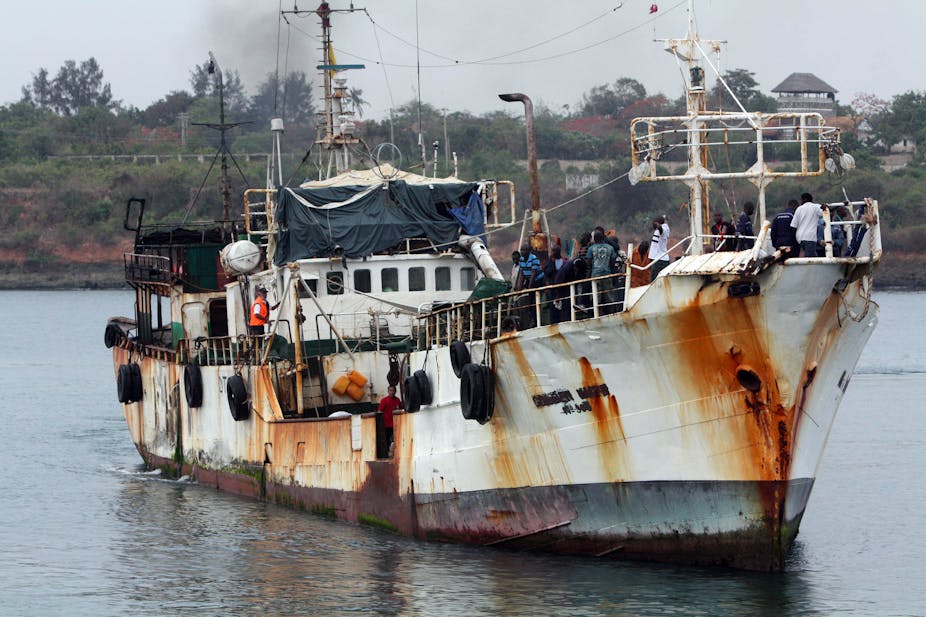Imagine you are a Somali pirate captain. You have hijacked a cargo ship after four weeks out at sea, 800 nautical miles from home. It will take maybe three, perhaps six, possibly 18 months to extract a US$4m ransom from the owner. You cannot stay on the high seas bristling with foreign navies, and on the coast there are rival gangs and militias who may try to take your ship. But you need the land for communications, food, water and khat, the preferred drug of your crew… Where do you find safe anchorage?
Imagine you are the imam or elder of a village on the Somali coast. The pirates offer you money for safe anchorage. But do you want pirates swaggering around your town, armed to their teeth and high on drugs? They will put off trading boats from Yemen and India. This will drive up prices and deprive your fishermen of customers. Their money will undermine your authority. What if your daughter marries a pirate, your nephew is killed in a skirmish, your son is tried for piracy in Kenya? How will your friends cope with reconnaissance planes overhead, what if they shoot? Anyway, most of the ransom money will be needed for bribes further up the political chain.
Our thought experiment shows that piracy is not an attractive revenue source. Most local elites refused to protect pirates – just as mafias do not necessarily protect every kind of organised crime in their territory. So who makes the choice to protect pirates?
Our analysis of the geography of piracy shows that no port city offered anchorage to pirates: the more trade opportunities the stronger the anti-piracy stance – ranging from local anti-piracy demonstrations to punitive raids on pirates further up the coast. Instead, the pirate anchorages are all located in arid regions well off the main sea trade routes. They have no connection to inland markets for their products, limiting their economic options to subsistence fishing and herding.
And even then, not everyone in these regions accepted the pirate dollar. We find that the intensity of piracy is strongly linked to local elites needing money for territorial defence against other clans or Islamist militias, or for regional election campaigns. We find that once political objectives were achieved the pirates were sent packing. The 2008 “pirate capital” of Eyl cleared its pirate anchorage in 2009 – shortly after the local clan’s candidate moved into the presidential villa in Puntland’s capital Garowe.
From the point of view of the pirate captain above our results seem perverse. If the pirates called the shots you would expect the greatest demand for anchorage in politically stable places. Instead we often see supply in disputed territories, such as the area around Harardhere, hotly contested between local clans and Islamist militias. However, because the decision to host pirates is one born out of economic desperation, the pirates do not greatly care who is in charge of the anchorage: whoever is in power will take their dollars – it is the only option. Vessel tracks of hijacked ships show pirates do not even bother to move their ships as battles rage on land.

What is the policy implication of this research? International interventions have not solved the underlying issues making hijack for ransom piracy in Somalia possible. Sea-based deterrence is working – but we still spend in the region of US$3 billion a year on a problem that generated an annual revenue stream of just US$50m for Somalia in 2008-2012 – almost all of it on the high seas. With the reduced level of attacks since 2012 the question arises whether private sector vigilance will be relaxed and whether the current level of naval commitment is sustainable in the long run. What can we do to change the operating environment of pirates in Somalia?
Most land-based approaches have focused on “hearts and minds” and “idle hands”. But this strategy ignores the fact that the hijack-for-ransom business is not limited by labour supply, but by the long-term protection arrangement for ships. The 15 attacks and suspicious approaches in 2013 show that once the navies leave and ships ditch their armed guards, the young men will be back for another chance of transforming their life. The more promising law and order approaches await a stable political settlement for Somalia and state structures that genuinely project power in the regions, and this may take a long time.
We focus on where the pirates find protection and find that it is governed by simple economic self-interest. We would advocate a developmental solution based on infrastructure investment tying remote coastal communities into the wider Indian Ocean and regional economy. The former president of Puntland repeatedly asked for a road to his home town of Eyl. His supporters would have been more than compensated for giving up piracy revenue. We don’t need a “contract out of piracy” – with the right incentives, self-interest will solve the problem.
A road will not solve all aspects of maritime crime. Unlike piracy, most maritime crimes (smuggling, trafficking, illegal fishing) are compatible with legitimate trade. However, infrastructure investment in remote areas will help build a secure and stable state. Poor and cut-off areas in Somalia have been fertile recruitment grounds and safe havens for all types of insurgents. We see the road as complementary to state-building and the law and order agenda, not as a substitute. But it is a good place to start land-based counter-piracy.

